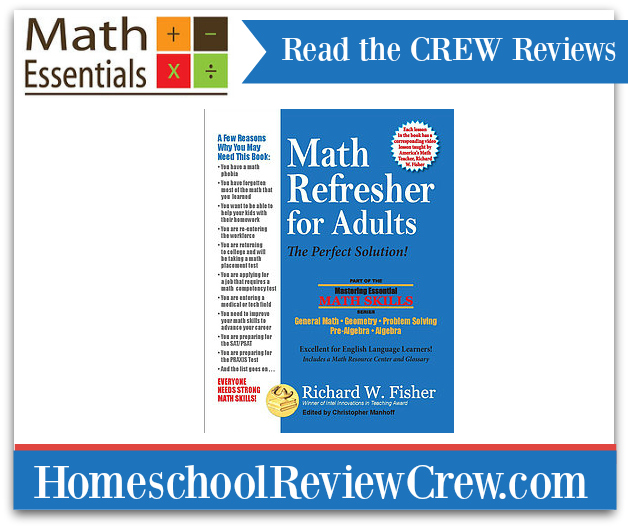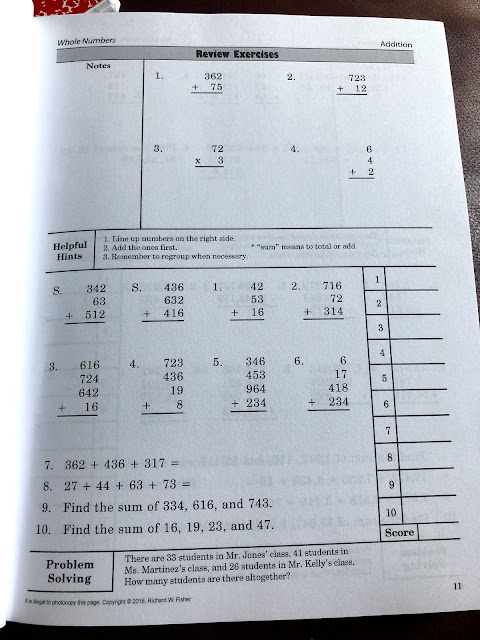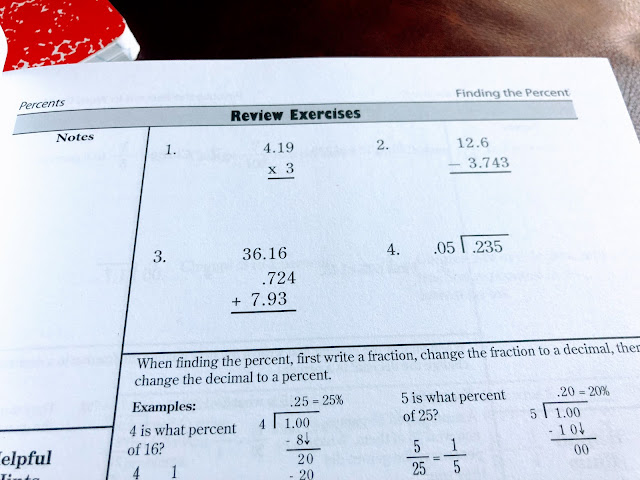Once we got the book in our hands and I was able to flip through it, I realized that while it wouldn't hurt him to work with the book, it was probably a little bit basic for his needs. It focuses on skills such as:
- General Math
- Geometry
- Problem Solving
- Pre-Algebra
- Algebra
While all of these are foundational for his courses, this book got re-assigned to Celia. She started Algebra I, but when she took the readiness test for her usual program, she felt she was shaky on some of the basics. She knew them, but not as well as she would like. She also is transitioning from private school to homeschool, so this was a perfect opportunity for me to assess her skills. Since that was the more pressing need, she found herself the proud short-term owner of the book.
Not Just For Adults
Since Celia was just beginning Algebra, we started with General Math. This book puts you in the "way back" machine, starting with fairly basic computation - two- and three-column adding, with regrouping. (If you're an adult working on this, you'll probably be calling it "carrying.")
Each lesson starts with four "review" problems. At the very start, it doesn't seem like "review" - just more of the same. As you get further into the book though, they pull from prior lessons. I like how this keeps presenting opportunities to practice skills. Let's face it, if you're doing a refresher course, it's because you know "one-and-done" re-exposure isn't going to be sufficient.
Celia felt she was ok with basic math; fractions, decimals, and percents were where she felt weak. Each page has only about fifteen problems (four review, ten on-topic, and one word problem), so while thirty problems a day sounds like a lot, it only took her about thirty minutes each day to work through them. She began by doing a page each of Fractions and Decimals, followed by Percents and Integers, alternating groupings each day. She decided that this would give her the opportunity to review several topics quickly, but also allow her to keep looping back, so it was constant repetition rather than a "topic blitz."
While this is a softcover workbook, it functions better as a textbook. While you could work some of the problems in the white space, you'd need exceptionally small and neat handwriting for some of them. Author Richard W. Fisher suggests copying problems onto a separate piece of paper -- which actually helps with understanding, because you're working from start to finish -- and then completing the problem. Rather than a bunch of scrap paper that could easily get lost, we opted for a copybook. I laughed when I saw the front of Celia's book, indentifying which Celia the book belonged to -- the "classroom experience" is still active in her mind. Last I checked, we only had one Celia in our school!
As I said, this was an excellent way for me to assess her skills. This problem showed a couple of weaknesses.
Math isn't just about getting the "right answer." You have to get the process right because otherwise, the correct answer is luck, not skill. Here, her first try didn't align her numbers correctly. I followed her thought process, but there were two issues -- either she missed squaring off the problem with a decimal place (and therefore a step in her work), or she wasn't lined up correctly. Her second try fixed the place issue -- but then her computation was off because she "brought down" her decimal point, as if she was adding, rather than "counting over," which definitely affected her answer. She realized what she did wrong, and got both the correct process and answer on the third go. While it seems like not a big deal when you're "just" multiplying in a single-step problem, this can become an issue as you move into multi-step problems. Forget algebra, let's just consider finding a discount and then adding sales tax to determine if you can afford a purchase: when you calculate that 7% add-on, you definitely want to make sure you're figuring based on the correct price!
Heading into Algebra, the extra practice with Integers was helpful. Again, we found that "setting up" was a weak spot. Celia wanted to jump right to calculation and answers. Many times, I had to say "COPY first, THEN work." Or, show how you get from one calculation to the next. While I can appreciate when I'm adding multiple numbers I tend to just go across the line in my head, when you're learning to add and subtract integers, it is crucial to do one step at a time until the skills have solidified.
We also learned that she tends to rush, leading to "stupid mistakes." When you get to upper levels of math, you have to take your time and do problems one step at a time. When I asked her how to solve this problem, her answer was to rush across the line, "Order of Operations, negative seven plus three is negative five, plus eight is three...Oh. Wait a minute." I pointed out that by trying to do it all at once, one mistake meant the entire thing was wrong. By doing it in steps, she had a chance to see where her mistake was and then an opportunity to fix it. Unfortunately, this is a habit that she didn't learn in school, so it's one we need to set up.
Again, it's not that she doesn't know her times tables -- when I said to her, "um...what is six times three?" she answered, "Eighteen!" Apparently, she just had a total brain fart here. Or she was rushing. (Very likely.) Learning this was as important as actually knowing her times table. As a parent/teacher, it tells me she needs reminders to slow down.
Celia will likely continue working through the book to the end. While she is continuing forward with Algebra 1, it won't hurt her skills to keep practicing basics and making sure she is rock-solid in them.
Quirks of the Book and Program
One thing I did not like was how the program alternated how it indicated multiplication during algebraic sections. Here, the answer key in the back was a definite help. We determined that the x in this problem meant "times," not "the variable x." That makes a big difference in solving. (Even if you do have to go back and slow down on the times table part.
There were several problems written like this, so when she came to one, I made her stop and ask me which way to do it, but just looking up the answer then primes the student to work backward from the answer, rather than seeking the path to get to the answer.
I also wish the answer key had more detail than "just" the final answers. For example, there are problems labeled as "muti-step," yet the Answer Key only gives the final answer. The page's Helpful Hints lists "Decide which operations to use and in what order" but there is no way to check if the student has chosen the right plan of attack. Yes, this book is supposed to be a refresher course, but I think it's really just providing practice, not actual "how to" refreshing.
It would really be helpful for both the teacher and the independent student to be able to see not only that it IS wrong, but WHY the answer is wrong. This might make a single book exceptionally voluminous, but perhaps the program could be converted to a two-volume set that includes a student workbook + answer key.
While I agree with Math Essentials that it is helpful for parents who want to help their children but need a refresher, there were sections where I just looked at the problem and said, "Hmmm...how about YOU show me, and then I'll check it." Yes, I was hoping that seeing how Celia did something might jog my memory. (Yes, I could sit and watch the videos, but, like many parents trying to juggle multiple kids, I was looking for the most expeditious route possible.)
Also included with the program book is access to Math Essentials web-based video instruction. An access code is included in the book for advanced Algebra tutorials. However, there is no direct correlation for this book -- you'll have to sort through topics from the prior volumes. The book cover advertises itself as "Excellent for English Language Learners" and for returning students, but I think these are is particular populations that may need extra hand-holding. It's not impossible to find the videos, but locating them definitely less "user-friendly" for this book than for other books. At first, we didn't even realize that the videos correlated, because we were looking for lessons for this book. It is sensible to use the previously produced videos, but it would have been nice to have a landing page for this volume that leads specifically to the correct videos, or even just a statement saying "Math Refresher students: choose the links that refer to the corresponding Refresher book section." Yes, we were able to figure it out, but no mention of the book at all makes Math Refresher feel like an afterthought.
Not Just for Crash Review!
Now that we've completed our official review period, I am going to also assign Jude to work in the book, too. He's just finishing elementary math and moving into Pre-Algebra, but looking ahead at his regular math program, I can see some areas where he would benefit from a few extra "basic math" problems each day. His usual program does build upon what the student has already learned in the Elementary program, but it will be a while before he returns to multiplying fractions. Knowing his strengths and weaknesses, I think it would be better for him to do a few problems of that here and there to keep practicing rather than hoping he can pull it from the depths of his brain a few months from now. Math Refresher will give him opportunities for extra practice without feeling like he's doing a "baby" workbook or a second curriculum. While I don't think ten or fifteen review problems a day is excessive for high schooler Celia, I probably will opt to have Jude do half a page each day -- odds on Day 1, evens on Day 2, which will both lessen the burden and extend the exposure. As for poor Luke, who had the book literally ripped from his hands...he's been taking short-session business law, economic theory, and English composition summer courses, so math review has been pushed to the side for now. He plans to start his math courses in the fall without a review, but keep this book handy if he finds there are things he's just not entirely clear on.
75 Crew Families have been brushing up on their math skills. Click the banner below to read their reviews.
Click here to read our review of Math Essentials: No-Nonsense Algebra.

Want to keep up with all of our adventures?
Subscribe below to get Adventures with Jude delivered to your inbox.
Enter your email address:
Delivered by FeedBurner
©2012- 2018 Adventures with Jude. All rights reserved. All text, photographs, artwork, and other content may not be reproduced or transmitted in any form without the written consent of the author. http://adventureswithjude.com











No comments:
Post a Comment